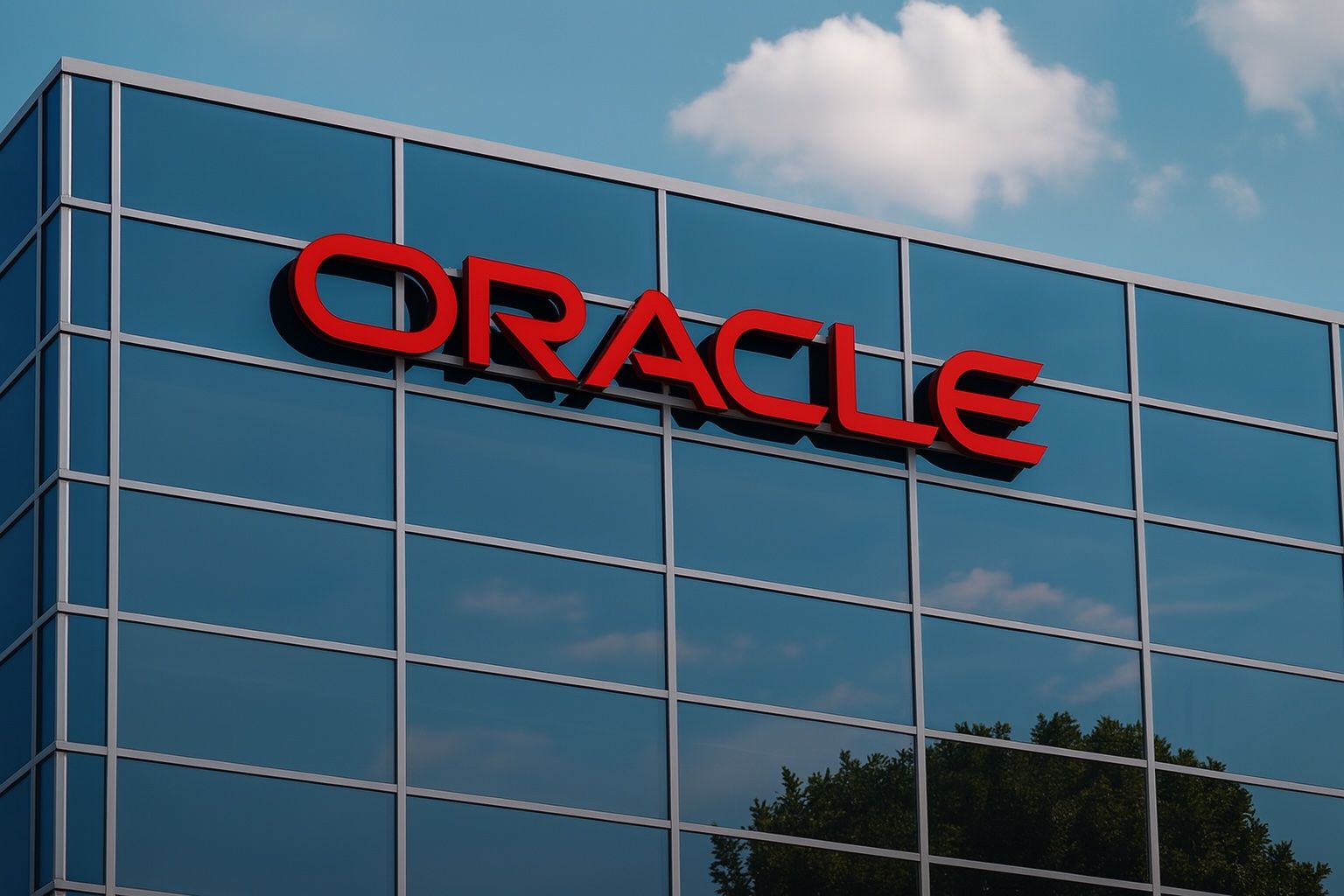- ORCL stock hovers around the high-$270s on Oct. 21, 2025, after a steep drop from over $300 last week [1]. Despite the pullback, shares have roughly doubled in 2025, up about 70–75% year-to-date amid intense AI-fueled enthusiasm [2].
- Volatility spiked recently: Oracle’s stock jumped ~3% on Oct. 16 following bullish AI announcements [3], then plunged 6.9% on Oct. 17 and another 4.9% on Oct. 20, as investors took profits and questioned Oracle’s lofty AI targets [4] [5].
- Big bets on AI: Oracle raised its long-term 2030 revenue goal to $166 billion (from $144B), implying ~75% annual growth, and reportedly secured a massive $300 billion cloud partnership with OpenAI to drive its AI cloud business [6] [7]. These ambitious plans briefly boosted the stock before skepticism set in.
- Analysts are divided: Bulls hail Oracle’s AI-fueled growth as “historic,” with some raising price targets to $360+ [8]. But skeptics warn the stock is overvalued – one firm even issued a Sell rating with a mere $175 target, calling Oracle’s huge AI deal “very risky” [9].
- Heady valuation: Even after the dip, Oracle is nearly $790 billion in market cap and trades around 45–60× earnings, a rich multiple above most peers [10]. ORCL’s ~70% rally has outpaced the broader tech sector – it “left even the ‘Magnificent Seven’ tech stocks trailing” this year [11] – but that premium now hinges on delivering spectacular growth.
- Outlook: Oracle is now a top contender in the AI cloud race alongside Microsoft, Amazon, and Google. Experts expect more turbulence ahead, as the market gauges whether Oracle can execute on its enormous AI backlog and meet aggressive forecasts [12]. The consensus on Wall Street still leans bullish (average 1-year target in the low $320s [13]), yet a “reality check” could come if Oracle’s AI ambitions falter.
ORCL Stock Soars, Then Stumbles in October
Oracle’s stock has been on a wild ride in 2025, propelled by the company’s aggressive push into cloud and AI. Shares hit an all-time high of roughly $345 intraday in early September after Oracle unveiled blockbuster AI cloud deals [14]. Even after recent declines, ORCL remains up nearly 75% year-to-date, vastly outperforming most tech peers [15]. This stellar rise turned choppy in mid-October, however, as investors swung from euphoria to caution in a matter of days.
During the week of Oct. 16, Oracle hosted its AI World conference in Las Vegas and issued ambitious long-term forecasts, which initially lifted the stock. On Thursday, Oct. 16, ORCL climbed about +3.1% to ~$313 per share [16] on excitement over new AI product launches and bullish financial targets. But by Friday Oct. 17, sentiment flipped – Oracle’s stock plunged nearly 7% (its worst single-day drop in months) as investors “sold the news” amid skepticism toward those lofty goals [17]. The sell-off continued on Monday, Oct. 20, with ORCL sinking close to 5% intraday and closing at $277.18 – extending its slide from last week’s peak [18]. In just two trading days, Oracle lost roughly 12% of its value, wiping out the prior week’s gains. Analysts pinned the reversal on mounting questions about Oracle’s ability to achieve the sky-high AI growth and profit targets it had just unveiled [19].
Despite this pullback, Oracle’s stock is still up dramatically in 2025. At around $278 per share as of Oct. 21, ORCL trades well above its January levels (near $160) and sits only about 15% below its record highs [20]. Volatility is nothing new for Oracle’s shareholders – the stock has seen over 20 days with 5%+ swings in the past year [21] – and the recent turbulence underscores how high expectations are for the company’s AI transformation. In the bigger picture, Oracle’s market value has swollen to roughly $780–$790 billion [22], placing it among the most valuable tech companies on the planet. The question now is whether Oracle can justify this valuation by delivering on its bold promises, or if the stock’s gravity-defying run will face a harsher reality check.
Big AI Bets: Earnings, Deals, and Targets
Oracle’s financial and strategic moves in recent months highlight just how aggressively it is betting on AI and cloud. In early September, the company announced strong fiscal Q1 2026 results (quarter ending Aug. 31, 2025): revenue of $14.93 billion (up 12% year-over-year) with cloud-related sales up 28% [23]. Oracle slightly missed the Street’s EPS estimate by a penny ($1.47 vs. $1.48 expected) [24], but investors largely shrugged off the minor miss. The real show-stopper was Oracle’s cloud deal momentum – management revealed Oracle had signed four enormous AI cloud infrastructure contracts in that quarter alone, involving just three large customers [25]. These unprecedented deals drove Oracle’s remaining performance obligations (backlog) to $455 billion, a 359% YoY surge [26]. CEO Safra Catz hinted on the earnings call that this is only the beginning, saying Oracle expects to sign “several additional multi-billion-dollar customers” in the coming months and forecasting backlog to exceed half a trillion dollars soon [27]. In other words, Oracle has amassed a war chest of future cloud revenue unlike anything seen before in enterprise tech.
One particularly eye-popping deal underpins this backlog: OpenAI (the creator of ChatGPT) will reportedly spend around $300 billion on Oracle’s cloud over five years [28]. This staggering partnership – internally code-named “Project Stargate” – was reported in the press but not officially confirmed by Oracle. If accurate, it represents one of the largest cloud commitments ever, essentially OpenAI entrusting Oracle to provide massive computing capacity for AI. Oracle’s leadership has alluded to such mega-deals without naming names. For instance, Larry Ellison (Oracle’s CTO) has boasted that leading AI firms chose Oracle because of its high-performance infrastructure and unique capacity to handle AI workloads. In any case, the OpenAI deal and others like it have turbocharged Oracle’s growth outlook, fueling Wall Street’s excitement but also drawing scrutiny (given the sheer scale of the numbers).
Buoyed by these wins, Oracle has raised its long-term targets dramatically. During the Oracle AI World event (Oct. 16), management updated its guidance to aim for $166 billion in total revenue by 2030, up from a previous $144B goal [29]. Hitting $166B would imply an astonishing ~75% compound annual growth over the next five years – an aggressive trajectory for a company of Oracle’s size. Much of that growth is expected to come from cloud infrastructure: Oracle forecasts its cloud (OCI) revenue will reach $18B in FY2026 and soar to roughly $144B in four years [30] [31]. For perspective, Oracle’s total revenue in the last fiscal year was around $50B; reaching the new 2030 target would mean more than tripling the business. Oracle also addressed profitability, projecting that its AI cloud infrastructure business could achieve 30–40% gross margins by 2030, a big leap from the ~16% margin estimated recently for OCI [32]. This suggests Oracle expects economies of scale (and perhaps pricing power) to greatly improve cloud profitability as it ramps up volume. Investors initially cheered these lofty goals, as evidenced by the stock’s rise on Oct. 16. But as we saw, the lack of concrete detail on how Oracle will fund and execute this rapid expansion gave many observers pause [33].
On the strategic front, Oracle has been busy forging alliances and launching products to bolster its AI cloud push. In mid-October, just before its stock reversed, Oracle announced notable partnerships with Zoom and Duality Technologies, as well as deeper integration of NVIDIA’s AI hardware into Oracle Cloud – news that actually sent ORCL stock up 5.4% in a single day earlier that week [34]. The Zoom deal, for instance, involves Zoom deploying its video conferencing on Oracle’s cloud infrastructure, highlighting Oracle’s inroads with high-profile enterprise clients. The Duality partnership (with a cryptography/AI firm) underscores Oracle’s focus on AI and data security solutions. Oracle also expanded its collaboration with NVIDIA to offer advanced GPU-powered “AI superclusters” for customers – a move aimed at keeping pace with rivals in providing the best AI model training and inferencing capabilities.
At the Oracle AI World conference (Oct. 15–16), the company rolled out a slew of new AI-driven products. A headline announcement was the Oracle AI Agent Marketplace, which allows Oracle Cloud Applications customers (ERP, HR, CRM, etc.) to easily deploy pre-built AI “agents” in their software [35] [36]. As Oracle’s EVP Chris Leone explained, in the age of intelligent automation these AI agents act like embedded smart assistants in enterprise workflows – for example, automatically flagging anomalies in accounting or speeding up HR onboarding with AI chatbots [37] [38]. Notably, IBM was on stage as a key partner: IBM announced three new AI agents built on Oracle’s platform (for finance and supply chain tasks) and plans more, highlighting a growing Oracle–IBM AI partnership [39] [40]. Oracle also teased an upcoming “Oracle AI Database” designed to run generative AI models directly on customer data – indicating the company’s intent to weave AI into its core products (like the Oracle database) in a way that competitors like Microsoft and Snowflake are also pursuing. All these initiatives send a clear message: Oracle is reinventing itself around AI and cloud, moving aggressively to position its technology at the center of the next enterprise computing wave.
Interestingly, Oracle’s transformation isn’t just technological – it’s also organizational. In late September, the company announced a major leadership transition. Longtime CEO Safra Catz (who has led Oracle since 2014) will step down and become Vice Chair, while Clay Magouyrk (head of Oracle Cloud Infrastructure) and Mike Sicilia (head of Oracle’s vertical industry applications) have been appointed as co-CEOs effective next year [41]. Founder Larry Ellison will remain as Executive Chairman and CTO. This shuffle was seen as a natural succession aligning with Oracle’s cloud focus – analysts at Evercore noted that both Magouyrk and Sicilia are well-known to investors and their elevation “solidifies the importance of the Cloud and Industry businesses as growth levers” [42]. In other words, Oracle is putting its cloud and AI talent directly in charge, signaling that the company’s future rests on those areas. Unlike some rivals, Oracle hasn’t made any blockbuster acquisitions in 2025; instead it’s channeling resources into organic growth – namely, massive capital expenditures to expand its cloud data centers. Oracle reportedly tripled its CapEx year-on-year to build out GPU-rich infrastructure for AI demand [43]. This heavy investment mode may temper near-term earnings, but Oracle’s bet is that it will pay off via a much larger revenue base in the coming years.
Analysts Split on Oracle’s Prospects
Oracle’s dramatic moves have elicited mixed reactions on Wall Street, with bulls and bears painting very different future scenarios for ORCL stock. On the bullish side, many analysts see Oracle’s AI pivot as a game-changer that could unlock years of high growth. Jefferies, for example, touted Oracle’s recent AI-driven quarter as “truly historic” and hiked its price target to $360 [44]. UBS and Bank of America are even more optimistic, reportedly setting street-high targets in the $360–$370 range on Oracle, citing the company’s newfound momentum in cloud and AI [45]. To put that in context, Oracle shares currently trade around $278 – so those targets imply at least 30% upside. Overall, out of dozens of analysts covering Oracle, the majority lean positive: as of mid-October, 30+ analysts have a Buy or Strong Buy rating, versus only single-digit Hold or Sell ratings [46]. MarketBeat data shows a consensus analyst rating of “Moderate Buy” with an average 12-month price target around $324 [47] [48]. That consensus target is above Oracle’s current price, reflecting confidence that the stock will recover and climb further – albeit with less dramatic gains than it logged earlier this year.
On the bearish side, a vocal minority of analysts and experts are urging caution, arguing that Oracle’s stock has run too far, too fast. One concern is valuation: by some measures Oracle now trades at a forward price-earnings ratio in the mid-40s to 50s [49], well above the likes of Microsoft or other cloud peers. Redburn Partners made headlines by launching coverage on Oracle with a Sell rating and a mere $175 price target [50] – an unusually low call for a major tech stock. Redburn’s analyst argued that the market is “overestimating” Oracle’s AI opportunity, calling the supposed $300B OpenAI deal “very risky” because there’s no guarantee Oracle will see all that revenue materialize profitably [51]. In other words, skeptics worry Oracle might be over-promising – and even if the deals are real, fulfilling them could require huge costs (e.g. building data centers, buying chips) that eat into margins. Valuation comparisons are also front-of-mind: Oracle’s enterprise value is now ~11 times its annual revenue, a rich multiple that assumes strong growth ahead. Any sign of growth hiccups could spur a sharp correction, bears warn, given how much optimism is baked into the stock price.
Even some analysts who are bullish on Oracle acknowledge there are execution risks. After Oracle unveiled its aggressive 2030 outlook, Jefferies analyst Brent Thill noted that the company provided scant detail on capital expenditures – i.e. how Oracle plans to invest enough to meet surging AI demand [52]. Oracle will likely need to spend tens of billions on new hardware and data centers; Thill questioned Oracle’s financing strategy for this expansion, especially since Oracle just raised $18 billion in debt in September [53]. Similarly, JPMorgan’s Mark Murphy pointed out that Oracle’s own forecasts show revenue growth eventually slowing toward 2030, which suggests the lofty interim targets may be setting the bar too high [54]. Murphy cautioned that while Oracle’s near-term cloud growth is impressive, the longer-term compound growth implied (75%/year) is virtually unheard-of for a company of Oracle’s size, and the tech industry has a mixed record when it comes to delivering on multi-year hyper-growth plans. These kinds of comments from Thill, Murphy, and others contributed to the market’s more skeptical stance post-event – essentially, Oracle gave big promises, and now it has to prove it can deliver, quarter after quarter.
The span of analyst price targets illustrates how polarizing Oracle’s outlook has become. On one end, you have extremely bullish calls (e.g. Wolfe Research upping their target to $400 [55] – a bet that Oracle will continue smashing expectations). On the other end, you have the likes of Redburn at $175. According to a recent compilation, current analyst targets on ORCL range from a low of ~$175 to a high of $400 [56], a $225 spread. That is an unusually wide gap for a mega-cap stock, underlining the uncertainty around Oracle’s future earnings power. As one commentator quipped, Oracle’s stock surge has been so exceptional that it “left even the ‘Magnificent Seven’ tech stocks trailing” this year [57] – but after such a run, “it must deliver” on its backlog and promises to sustain investor confidence [58]. In short, Wall Street’s love affair with Oracle is real but not unconditional. The company has convinced many that it can be a winner in the AI cloud race, yet it will need to back up the hype with consistent performance (and perhaps more transparency on its strategy) to win over the doubters.
Oracle vs. Rivals: How ORCL Stacks Up
Oracle’s resurgence is unfolding in the context of a broader tech battle for AI and cloud dominance. In cloud infrastructure – renting out computing power and storage – Oracle is effectively challenging the “Big Three” hyperscalers: Amazon Web Services, Microsoft Azure, and Google Cloud. Those giants still command the lion’s share of the cloud market [59], with far larger customer bases and data center networks than Oracle. However, Oracle is attempting an unconventional approach to close the gap. The company has positioned itself as a specialist for high-performance AI workloads, leveraging its strength in database and hardware engineering. Interestingly, Oracle is also collaborating with its competitors in certain ways. It has struck deals that allow Azure, AWS, and Google Cloud customers to interconnect with Oracle’s cloud for specific services [60]. For example, Oracle and Microsoft have a partnership (Oracle Database Service for Azure) that lets Azure users tap Oracle’s database running in Oracle Cloud. And Oracle’s multi-cloud agreement with Microsoft was recently expanded so Azure can directly operate Oracle’s Exadata hardware in Azure data centers [61]. These tie-ups signal that large enterprises increasingly want flexibility to run different workloads on different clouds – and Oracle is trying to insert itself wherever it can add value (like database and AI-heavy tasks), even if it means partnering with rivals. Oracle’s bet is that the cloud market isn’t winner-take-all; instead, many customers will use multiple cloud providers (for resiliency, cost, or capability reasons), and Oracle can carve out a lucrative niche as one of those providers, especially for AI projects requiring lots of GPUs and data throughput [62] [63].
In the enterprise software arena, Oracle also faces formidable peer competitors like SAP and Salesforce. All these incumbents are racing to integrate generative AI features into their software suites – whether it’s CRM, ERP, human resources, or supply chain apps [64]. Salesforce has its Einstein AI, Microsoft has Copilot in Office, SAP is adding AI to its ERP, and so on. Oracle’s response is to embed AI across its Fusion Cloud Applications and industry-specific offerings, as seen with the AI Agent Marketplace and upcoming AI-enabled database. One edge Oracle touts is its control of the “full stack.” Oracle builds the database technology, the middleware, the infrastructure, and the applications – a vertically integrated approach which, in theory, can yield performance and integration benefits. For instance, Oracle can optimize AI algorithms down to the database level and hardware level in ways a pure software SaaS provider (like Salesforce) cannot. Analysts have noted that Oracle’s deep experience managing massive enterprise data sets (think of the largest banks, telecoms, etc., many of which run Oracle databases) gives it credibility in addressing AI for big business [65]. If an enterprise wants to apply AI to its treasure trove of internal data, Oracle can pitch itself as uniquely qualified to handle that securely and effectively, combining its databases with new AI models. Still, competition will be intense. Companies like Microsoft and Google not only offer competing cloud platforms but are also developing their own AI chips, models, and software integrations. Amazon’s AWS, the market leader, is investing heavily in its own AI services too. And on the software side, Workday, SAP, Salesforce and others will fight to retain their customers by adding similar AI capabilities. Oracle’s resurgence has certainly put it back on the map, but it remains to be seen how much share it can take from these behemoths in the long run.
When it comes to stock performance, Oracle has recently outshone most of its rivals – a fact that has caught many by surprise. ORCL’s ~70% surge in 2025 is better than the gains of broader indices and even many high-profile tech names [66]. To compare, the S&P 500 index is up roughly 15–20% this year (buoyed by tech), and mega-cap peers like Microsoft and Alphabet (Google), while enjoying solid rallies, have seen more modest percentage increases than Oracle. Even NVIDIA, arguably the poster child for the AI boom, has had its stock plateau or pull back in recent months, whereas Oracle kept climbing to new highs until October. Oracle’s outperformance partly reflects that it started the year from a lower base (investors did not initially view Oracle in the same league as an AI play), and then enthusiasm exploded as Oracle proved it could win marquee AI business. With Oracle’s market cap now around $790B [67], it has vaulted into the upper echelon of tech companies by value – sitting not far behind Google ($1.7T) and Meta ($900B+), and ahead of legacy rival IBM (~$140B) or cloud peer Salesforce (~$200B). Of course, market cap isn’t everything: Oracle’s revenue (~$55B annually) is still a fraction of Microsoft’s or Amazon’s, which is why skeptics point to Oracle’s valuation multiples being lofty. Oracle’s stock currently trades at roughly 45–60 times earnings [68], compared to Microsoft at around 30× and the overall market near 20×. This premium valuation indicates high expectations for Oracle’s growth. If Oracle can sustain, say, 30%+ annual revenue increases for a few years, the valuation might be justified – but if growth disappoints, the stock could have more downside. In summary, Oracle now finds itself both as an underdog and a front-runner: an underdog in the cloud market share battle, but a front-runner in terms of stock performance and investor attention. How it navigates competition with the likes of AWS/Azure and product battles with SAP/Salesforce will be critical to maintaining its momentum.
What’s Next: Forecast and Analysis
Looking ahead, the road for Oracle’s stock is likely to be bumpy but exciting. In the short term, expect continued swings and volatility. Oracle’s share price is now highly sensitive to perceptions of its AI story – any new contract win, product launch, or analyst upgrade could spark a rally, while any hint of hiccups (slower growth, margin pressure, etc.) could send shares reeling. The past week’s events are a case in point: Oracle delivered thrilling long-term targets, but the lack of clarity on execution led to a swift pullback. Many traders are engaging in “buy the rumor, sell the news” behavior around AI announcements. It’s worth noting that tech stocks broadly have been on an AI-driven tear this year, and we have seen sharp reversals in some names after initial euphoria [69]. For Oracle, after an ~80% run-up since January, some consolidation isn’t surprising [70]. Profit-taking set in as soon as doubts emerged about Oracle’s projections [71]. Macro-economic factors (interest rates, geopolitics) could also influence ORCL in the near term; high-growth, high-multiple stocks tend to be more volatile if the market turns risk-averse. Investors should be prepared for a trading range where Oracle stock oscillates as bulls and bears duke it out over each new data point.
In the medium term (next 6–18 months), Oracle’s stock trajectory will likely hinge on whether the company can start delivering tangible results from its big bets. The next few quarterly earnings reports will be crucial. Oracle will need to show strong cloud revenue growth – not just big contract signings, but actual consumption of Oracle Cloud services by customers like OpenAI, Zoom, and others. The company’s fiscal Q2 2026 results (due in December) and guidance will be closely watched for signs that AI deals are translating into higher revenue and margins. If Oracle can put up accelerating cloud growth numbers (e.g. 30%-40%+ year-over-year) consistently, it will reinforce the bullish case and could propel the stock back toward its highs. Some analysts believe Oracle’s current backlog could indeed yield outsized growth in the next year, with optimistic scenarios putting the stock in the mid-$300s within 12 months [72]. For instance, UBS and BofA’s $360+ targets imply Oracle might test new record highs if all goes well [73].
However, Oracle’s path is not without obstacles. The company’s stated aim of reaching $166B in revenue by 2030 is extremely ambitious – it assumes not only that AI demand stays red-hot, but also that Oracle captures a significant portion of that demand while fending off heavy competition. To achieve this, Oracle will likely have to continue massive capital investments, possibly taking on more debt or sacrificing short-term profits to build capacity. There’s also execution risk in integrating and scaling huge contracts quickly – for example, deploying potentially tens of thousands of new GPUs and building data centers at a rapid clip, all while ensuring quality service for customers. Any delays or cost overruns in these projects could temper Oracle’s growth or hurt margins. Additionally, if enterprise AI adoption slows down (for instance, if economic conditions cause companies to tighten IT spending), Oracle’s lofty projections might prove too optimistic.
Market sentiment could thus swing on developments like: updates on the OpenAI deal (do Oracle and OpenAI confirm or expand the partnership?), new customer wins or losses (is Oracle poaching big cloud clients from rivals?), competitive responses (do AWS or Azure slash prices or introduce offerings that undercut Oracle’s niche?), and tech innovation (does Oracle successfully launch its AI Database and other new services, and do they gain traction?). On the competitive front, it will be interesting to see if Oracle’s alliance strategy (working with rivals) continues or if the cloud war turns more zero-sum. If Oracle’s multi-cloud play yields more partnerships (maybe with Google next, or deeper ties with Microsoft), that could strengthen its credibility.
Most analysts still fall in the camp that Oracle has more upside than downside, given the momentum in its business [74]. The consensus price target in the low-$320s suggests Wall Street sees double-digit percentage gains from current levels [75]. But importantly, that consensus is an average of very disparate views – meaning the actual outcome could be quite a bit higher or lower. As one analyst put it after Oracle’s AI event, the company now has an “exceptional backlog” of AI deals that confirms it as a real player, “but now it must deliver” to justify the hype [76]. For investors, Oracle has transformed from a slow-and-steady legacy software name into a high-growth story stock centered on AI. Story stocks can be exhilarating winners if the story comes true – or painful if the story unravels. Over the coming months, expect Oracle’s share price to closely track the narrative of its AI/cloud execution. If positive headlines keep coming (new deals, earnings beats, analyst upgrades), ORCL could regain its highs and then some. If cracks appear in the story (project delays, competitive wins against Oracle, etc.), the stock may stumble further. Either way, 2025 has cemented Oracle as one of the market’s most intriguing tech stocks – one that has surprised skeptics so far, and now faces the real test of living up to its own ambitious vision.
Sources: Oracle’s investor reports and financial filings; commentary from financial news outlets and analysts (Yahoo Finance, Nasdaq/RTTNews, Investopedia) on Oracle’s recent stock moves and AI plans [77] [78]; insights from tech industry sources (Reuters, ts2.tech) on Oracle’s major cloud deals, product announcements, and leadership changes [79] [80]; expert analysis and quotes from Wall Street analysts via MarketBeat, Siolla News, and others [81] [82]. These cover Oracle’s latest earnings, the $300B OpenAI deal reports, Oracle’s 2030 targets, and the range of bullish and bearish outlooks for ORCL stock.
References
1. www.investing.com, 2. ts2.tech, 3. www.investing.com, 4. www.investopedia.com, 5. news.siolla.com, 6. news.siolla.com, 7. news.siolla.com, 8. ts2.tech, 9. ts2.tech, 10. www.marketbeat.com, 11. ts2.tech, 12. ts2.tech, 13. www.marketbeat.com, 14. ts2.tech, 15. news.siolla.com, 16. www.investing.com, 17. news.siolla.com, 18. www.investopedia.com, 19. www.investopedia.com, 20. www.investing.com, 21. www.nasdaq.com, 22. www.marketbeat.com, 23. ts2.tech, 24. www.marketbeat.com, 25. ts2.tech, 26. ts2.tech, 27. ts2.tech, 28. ts2.tech, 29. news.siolla.com, 30. ts2.tech, 31. ts2.tech, 32. news.siolla.com, 33. news.siolla.com, 34. www.nasdaq.com, 35. ts2.tech, 36. ts2.tech, 37. ts2.tech, 38. ts2.tech, 39. ts2.tech, 40. ts2.tech, 41. ts2.tech, 42. ts2.tech, 43. ts2.tech, 44. ts2.tech, 45. ts2.tech, 46. www.marketbeat.com, 47. www.marketbeat.com, 48. www.marketbeat.com, 49. ts2.tech, 50. ts2.tech, 51. ts2.tech, 52. news.siolla.com, 53. news.siolla.com, 54. news.siolla.com, 55. www.marketbeat.com, 56. www.marketbeat.com, 57. ts2.tech, 58. ts2.tech, 59. ts2.tech, 60. ts2.tech, 61. ts2.tech, 62. ts2.tech, 63. ts2.tech, 64. ts2.tech, 65. ts2.tech, 66. ts2.tech, 67. www.marketbeat.com, 68. www.marketbeat.com, 69. ts2.tech, 70. ts2.tech, 71. news.siolla.com, 72. ts2.tech, 73. ts2.tech, 74. www.marketbeat.com, 75. www.marketbeat.com, 76. ts2.tech, 77. www.investopedia.com, 78. www.nasdaq.com, 79. ts2.tech, 80. ts2.tech, 81. news.siolla.com, 82. ts2.tech






